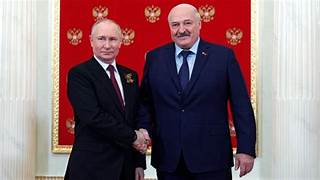Russia and Belarus have commenced the second stage of non-strategic nuclear drills in response to ongoing Western military aid to Ukraine, which intensifies regional tensions.
Belarus, a key ally of Russia, underscores this action as a serious signal of their readiness to confront NATO’s increased interference. Russia firmly warns NATO to step back in order to de-escalate tensions. Moscow emphasizes that NATO’s actions are the primary drivers for conflict escalation and the hindrance to the peace process. This stance highlights Russia’s intolerance for further NATO involvement in the region.
Russia has announced significant military drills involving tactical nuclear weapons, signaling a stern warning to Western powers against their increased involvement in Ukraine. This move comes as a direct response to aggressive rhetoric from officials in Washington, Paris, and London about deploying troops in the conflict zone.
According to the Russian Foreign Ministry, these drills are seen as a necessary step to counteract threats from NATO countries and their destabilizing actions, which exacerbate the conflict in Ukraine and pose an additional risk to Russian security.
A major focus of these drills is to underscore the disastrous effects of NATO’s strategic risks. Russia hopes this will deter Western nations from providing further assistance to Kiev, which they believe could escalate the conflict into a direct confrontation with Russia. The Foreign Ministry emphasized that Western actions are pushing towards an open military clash between NATO and Russia, a situation fraught with peril.
Russia has highlighted the West’s threats of direct assistance to Kiev, including advanced weapons transfers to the Zelensky regime. Moscow views these actions as reckless. The drills are a firm reminder to Western leaders to reconsider their positions to avoid further escalation.
The message from Russia is clear: it is prepared to defend its sovereignty and territorial integrity at all costs. The drills serve as a deterrent, signaling Russia’s readiness to protect its state without necessarily escalating to full-scale nuclear war.
Previously, Russian and Belarusian troops underwent training to operate Iskander missiles and equip Kinzhal hypersonic missiles with specialized warheads. The current drills mark the second stage of these exercises, focusing on the use of non-strategic nuclear weapons. This phase was initiated following a decision by Russian President Vladimir Putin.
The Russian Defense Ministry announced the commencement of this second stage, which involves joint training of units from the armed forces of Russia and Belarus. The primary objective is to maintain readiness for the combat use of non-strategic nuclear weapons, ensuring the sovereignty and territorial integrity of Russia and Belarus.
In a visit to the State Centre for Deployment and Retraining of Flight Personnel, President Putin underscored the importance of these exercises. The first stage of the drills involved acquiring specialized ammunition for the Iskander tactical missile system, with aviation forces training to equip Kinzhal hypersonic missiles with special warheads. Missile units from the Southern Military District also participated in these training exercises.
The Russian Foreign Ministry elaborated that these drills should be viewed in the context of hawkish statements by Western politicians and NATO’s destabilizing activities. The exercises are intended as a stark warning to NATO to refrain from escalating the situation in Ukraine, reflecting Russia’s firm stance on maintaining its security and sovereignty.
In addition to the drills, Moscow has issued warnings regarding the potential delivery of F-16 fighter jets, it is a lightweight, multirole fighter, to Ukraine by NATO. Russia considers this a deliberate provocation and will treat any such aircraft as potential nuclear carriers. This stance is reinforced by Poland’s discussions about hosting US nuclear weapons and reports of French mercenaries in Ukraine.
Earl Rasmussen, a retired US Army Lieutenant Colonel, interprets Russia’s drills as a serious signal to Western leaders. He cautions against further escalation, warning that Russia is prepared to protect its state by any means necessary, including the potential use of tactical nuclear weapons if provoked.
In summary, Russia’s military drills involving non-strategic nuclear weapons serve as a powerful deterrent against Western escalation in Ukraine. Moscow’s message is firm and clear: it is ready to defend its sovereignty and territorial integrity, and any further provocations could have catastrophic consequences.








